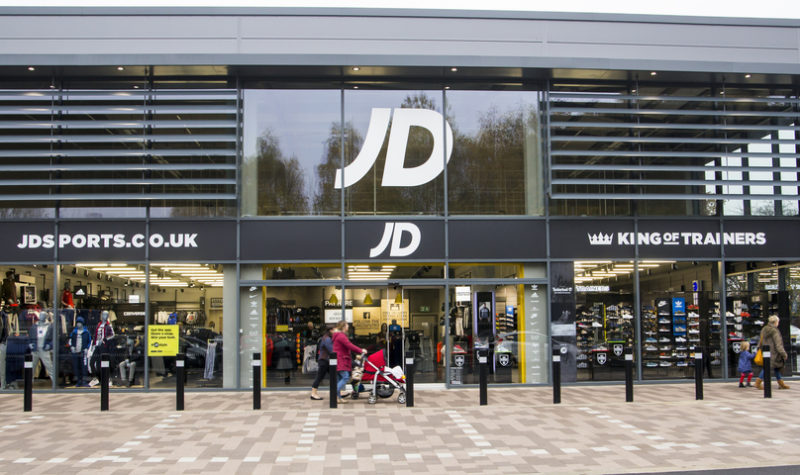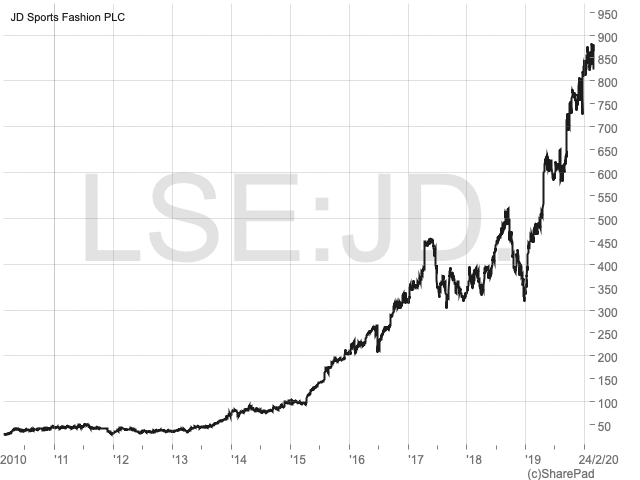JD Sports Fashion: bucking the retail trend

| Master Investor Magazine
Never miss an issue of Master Investor Magazine – sign-up now for free! |
The retail sector may not be the most popular industry in which to invest at the moment. But JD Sports Fashion could offer long-term investment appeal, writes Robert Stephens, CFA.
Investing in UK retail stocks may not be in fashion at the moment, but JD Sports Fashion’s (LON:JD.) financial performance shows that the right business strategy can lead to high returns. The sports, fashion and outdoor brands retailer has increased its earnings per share at an annualised rate of 32% over the past three years.
It has benefited from a multi-channel strategy which has expanded the business into new territories, thereby reducing its reliance on the UK. It has ambitious plans to further grow its international presence, which could act as a catalyst on its financial performance. Alongside this, it has growth opportunities in adjacent market segments such as gyms, while its efficiency is likely to be boosted by an increasing use of automation.
Risks such as weak consumer confidence in the UK and difficult trading conditions in its outdoor segment are likely to remain in 2020. However, wage growth is substantially ahead of inflation and could lead to an improving outlook for UK consumers. Therefore, even though the stock trades on a high valuation compared to many of its retail peers, it appears to deserve a premium valuation owing to its attractive growth prospects.
International expansion
The positive contribution of the company’s international presence was evident in its Christmas 2019 trading update, which reported strong growth across its international stores. Since they contribute around 55% of its total revenue, their ability to deliver strong like-for-like sales growth suggests that JD’s international-expansion strategy is paying off.
It expects to maintain its pace of growth in regions such as continental Europe, Asia Pacific and the US. For instance, in the first half of the 2020 financial year it opened 23 new stores in Europe. This increases its presence in mainland Europe to 11 countries, and the company expects to open a similar number of stores in the second half of the current financial year.
Additionally, it opened seven new stores in Asia Pacific in the first half of the current year. It expects to maintain this pace of growth in the near term, and to further expand its presence in a region where growing wages are boosting consumer disposable incomes. The US, meanwhile, may have only six of the company’s stores at the moment, but it is expected to become a significant part of its future growth plans. It is the largest market in the world for sport lifestyle footwear and apparel, and could become a major contributor to the company’s sales and profit.
As well as offering growth potential, the company’s international stores reduce its overall risk. Should the UK economy experience a challenging period, JD may be less affected than many of its retail- sector peers.
UK performance
Clearly, the UK is still JD’s most important market in spite of its growing international presence. It has been able to attract a loyal customer base over recent years through a strategy which has focused on offering exclusive brands in a multi-channel environment.
It has strong relationships with major sporting-goods producers such as Nike and Adidas, and sells its own high-margin brands alongside them in a vibrant store setting that appeals to its target demographic of younger, fashion-conscious consumers. Continued investment in refurbishing its stores could differentiate its offering from those of its sector peers and improve its competitive advantage.
| Master Investor Magazine
Never miss an issue of Master Investor Magazine – sign-up now for free! |
JD has also invested heavily in its multi-channel offering. This allows its customers to shop seamlessly across its website and in its stores, which has led to 19% of its total sales being generated from its multi-channel operations. It has a strong presence on social media, and has invested large sums of capital in influencer marketing. This has proved to be a successful means of appealing to its core customer base, with this trend likely to continue due to the ongoing popularity of social-media sites such as Instagram.
Therefore, even if the UK economy experiences a difficult period, JD’s performance could prove to be relatively resilient. Evidence of this can be seen in its performance in the key Christmas trading period, when it reported positive like-for-like sales from its global operations.
UK growth prospects
The prospects for retailers with UK operations may prove to be more encouraging than has been the case in recent years. Wage growth reached an 11-year high in 2019, and is now around 1.9 percentage points ahead of inflation. This could mean that consumers adopt an increasingly relaxed attitude towards spending, with their disposable incomes likely to rise over the medium term in real terms.
Furthermore, employment levels are high and the UK’s GDP growth is forecast to rise by 0.2 percentage points to 1.4% in 2020. Clearly, Brexit poses an exceptional risk over the short run. However, a trade deal seems likely to be signed between the UK and EU within the transition period. Consumer confidence could improve further, following its largest rise in three years in December, if an agreement becomes increasingly likely.
Investment opportunities
The company has growth opportunities in niche areas. For example, it has built a network of 25 gyms in the UK that together have 120,000 members between them. JD plans to open a further four gym sites before the end of the 2020 financial year. This could provide cross-selling opportunities for its products, as well as diversify the business away from high-street retailing. It may also help it to capitalise on an ongoing shift among younger consumers towards leading healthier lifestyles, with gym membership likely to become akin to a necessity for many people in the long run.
JD is seeking to expand its presence in premium-brand fashion. For example, it has made numerous small and selective acquisitions to enhance its profile in higher price-point market segments. This could broaden its customer demographic and improve its margins. It is also aiming to acquire Footasylum, which has 69 stores in the UK and a product range which appeals to older consumers. The purchase is currently subject to an ongoing Competition and Markets Authority investigation, but if it goes ahead then it could act as a means of broadening its appeal to a wider range of consumers.
The retailer has invested in improving the efficiency of its supply chain in the last few years. For instance, it has invested in the installation of additional automation equipment at its primary warehouse in the UK. This could help to lower its costs and increase margins. It has also established a new operational section at its primary warehouse that will provide a bespoke packing and fulfilment service for its premium fashion businesses. This could elevate the shopping experience for its premium customers and help to further differentiate its offering from sector peers.
Potential threats
JD’s half-year results highlighted the challenges it has faced within its outdoor segment. They were caused by internal factors resulting from the company’s decision to switch to a central warehousing model that aims to integrate the supply chains of its various outdoor businesses. The process of implementing that change proved to be more difficult than the business had anticipated, and led to reduced availability of stock. Further challenges could be ahead as the process is set to continue in the first quarter of the 2020 calendar year.
The company’s rising profitability in the past three years has led to improving investor sentiment. The stock’s price gained 146% in the 2019 calendar year, and it now trades on a price-earnings ratio of 30.9 using its 2019 financial figures. This is a significantly higher valuation than most of its retail-sector peers, and suggests there is a lack of margin of safety available for new investors. However, with JD forecast to produce a 12% rise in earnings per share in its 2021 financial year, followed by growth of 11% in 2022, its premium valuation may be justified over the long run.

Investment potential
JD’s profit growth over the past few years is a trend which could continue. The company is set to outperform many of its peers as a result of its international-expansion plans, as well as its differentiated, multi-channel offer. As it continues to refurbish its stores, make acquisitions and expand into fast-growing markets such as the US and Asia, its financial performance could improve yet further.
Alongside this, its prospects in the UK could be more robust than expected. Consumer confidence has improved since the general election, while real-terms wage growth may encourage consumers to relax their spending as the Brexit process nears its conclusion.
JD’s near-term financial performance could be held back by ongoing issues in its outdoor segment, while its valuation is substantially higher than most of its sector peers. However, its investments in improved supply-chain efficiency and in establishing a stronger presence in adjacent categories and premium price points could pay off in the long run.
The retail sector may not be the most popular industry in which to invest at the moment. But JD’s strategy, growth forecasts and increasingly international focus may mean that its stock-price growth continues to impress.

Comments (0)